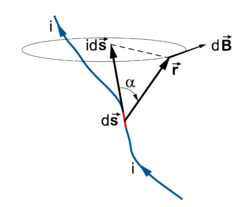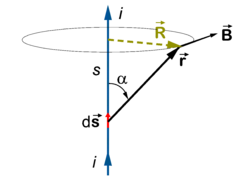Biot-Savart law: Difference between revisions
imported>Paul Wormer |
imported>Paul Wormer |
||
| Line 33: | Line 33: | ||
:''From hereon vectors are indicated by bold letters, arrows on top are omitted''. | :''From hereon vectors are indicated by bold letters, arrows on top are omitted''. | ||
In the above we wrote ''i'' for the current, which is equal to the current density ''J'' times the cross section ''A'' of the wire. If the current density ''J'' is not constant over the cross section, i.e., ''J'' = ''J''(<b>r</b>' ), we must use an integral over the cross section. Rather than introducing a surface element we multiply immediately by d''s'' and obtain an infinitesimal volume element <math>\scriptstyle d\mathbf{r}'</math>, | In the above we wrote ''i'' for the current, which is equal to the current density ''J'' times the cross section ''A'' of the wire. If the current density ''J'' is not constant over the cross section, i.e., ''J'' = ''J''(<b>r</b>' ), we must use an integral over the cross section ''A''. Rather than introducing a surface element we multiply immediately by d''s'' and obtain an infinitesimal volume element <math>\scriptstyle d\mathbf{r}'</math>, | ||
:<math> | :<math> | ||
i d\mathbf{s} = \iint_{A} \mathbf{J}(\mathbf{r}') d\mathbf{r}', | i d\mathbf{s} = \iint_{A} \mathbf{J}(\mathbf{r}') d\mathbf{r}', | ||
</math> | </math> | ||
where we assumed that the current density is a vector parallel to the segment d'''s''' and where | where we assumed that the current density is a vector parallel to the segment d'''s''' and where | ||
the volume element has height d''s'' and base an infinitesimal element of ''A''. The '''B'''-field at point '''r''', due to a volume ''V'' = ''As'' of the | the volume element has height d''s'' and base an infinitesimal element of ''A''. The '''B'''-field at point '''r''', due to a volume ''V'' = ''As'' of the current becomes, | ||
:<math> | :<math> | ||
\mathbf{B}(\mathbf{r}) = k \iiint_{V} \frac{\mathbf{J}(\mathbf{r}') \times (\mathbf{r}-\mathbf{r'})} | \mathbf{B}(\mathbf{r}) = k \iiint_{V} \frac{\mathbf{J}(\mathbf{r}') \times (\mathbf{r}-\mathbf{r'})} | ||
Revision as of 11:42, 7 February 2008
In physics, more particularly in electrodynamics, the law first formulated by Jean-Baptiste Biot and Félix Savart [1] describes the magnetic induction B (proportional to the magnetic field H) caused by a direct electric current in a wire. Biot and Savart interpreted their measurements by an integral relation. Laplace gave a differential form of their result, which now often is also referred to as the Biot-Savart law, or sometimes as the Biot-Savart-Laplace law. By integrating Laplace's equation over an infinitely long wire, the original integral form of Biot and Savart is obtained.
Laplace's formula
The infinitesimal magnetic induction at point (see figure on the right) is given by the following formula due to Laplace,
where the magnetic induction is given as a vector product, i.e., is perpendicular to the plane spanned by and . The electric current i is constant in time. The piece of the wire contributing to the magnetic induction can be seen as a vector of infinitesimal length ds and with direction tangent to the wire. The constant k depends on the units chosen. In rationalized SI units k is the magnetic constant (vacuum permeability) divided by 4π. The magnetic constant μ0 = 4π ×10−7 N/A2 (newton divided by ampere squared). In Gaussian units k = 1 / c (one over the velocity of light).
If we remember the fact that the vector r has dimension length, we see that this equation is an inverse distance squared law.
Formula of Biot and Savart
Take a straight infinitely long wire transporting the current i. Write, using R = rsinα (see the figure),
where is a unit vector perpendicular to the plane spanned by the wire and the vector perpendicular to the wire. Note that if moves along the wire all contributions from the segments to the magnetic induction are along this unit vector. Hence, if we integrate over the wire we add up all these contributions, so that
where, by the Pythagorean theorem,
Substition of y = s / R and y = cotφ = cosφ / sinφ, successively, gives
where i is the current and R the distance of the point of observation of the magnetic induction to the wire. The constant k depends on the choice of electromagnetic units and is 10−7 henry/m [= Vs/A = N/A2] in rationalized SI units. This equation gives the original formulation of Biot and Savart. The SI dimension of B is T [tesla: 1 T = 1 N/(Am), newton divided by ampere meter]. A field of 1 T (SI) corresponds to 10000 gauss (cgs units).
Generalized Biot-Savart law
- From hereon vectors are indicated by bold letters, arrows on top are omitted.
In the above we wrote i for the current, which is equal to the current density J times the cross section A of the wire. If the current density J is not constant over the cross section, i.e., J = J(r' ), we must use an integral over the cross section A. Rather than introducing a surface element we multiply immediately by ds and obtain an infinitesimal volume element ,
where we assumed that the current density is a vector parallel to the segment ds and where the volume element has height ds and base an infinitesimal element of A. The B-field at point r, due to a volume V = As of the current becomes,
Note that:
where we choose the nabla operator to act on the unprimed coordinates and hence it may be moved outside the integral, giving the following generalized form of the Biot-Savart law for the magnetic induction at point r:
where V is a finite volume segment of the current generating the B-field. The total B-field is obtained by having V encompass all current.
Maxwell equations
We will show that the expression for B given in Eq. (1) satisfies the Maxwell equations. This is of interest, since the Maxwell equations can be seen as a set of postulates for classical electrodynamics. We will show that the Biot-Savart law is a consequence of the postulates (although Biot and Savart made their discovery some forty-five years before Maxwell formulated his equations).
Since it is known from vector analysis that
for any vector field V(r), it is immediately clear that B satisfies the following Maxwell equation:
The one other Maxwell equation of interest is
where we assumed that there are no time-dependent electric fields present. In SI units 4πk is equal to the vacuum permeability μ0. In the proof we will need the following results
The first equation is well-known in vector analysis, the second follows by differentiating to the components of r and r' and equating. The third equation has a Dirac delta function on the right-hand side and follows from distribution theory. The last equation follows from charge density (ρ) conservation in conjunction with the continuity equation,
Now
In the first term of the last step we replaced the unprimed nabla by a primed one (times minus) and then applied a turn-over rule with the primed nabla. This turn-over rule can be justified by partial integration and gives a minus sign, or, in other words, nabla is an anti-hermitian operator. Using that the divergence of the current density vanishes and the defining property of the delta function, we get
This shows that B(r) of Eq. (1) (the generalized Biot-Savart law) satisfies this Maxwell equation.
References
- ↑ J.-B. Biot and F. Savart, Note sur le Magnétisme de la pile de Volta, Annales Chim. Phys. vol. 15, pp. 222-223 (1820)
Further reading:
- J. D. Jackson, Classical Electrodynamics, 2nd edition, John Wiley, New York (1975).























